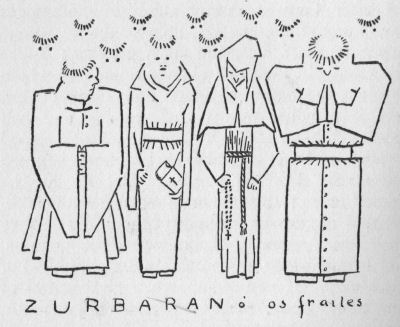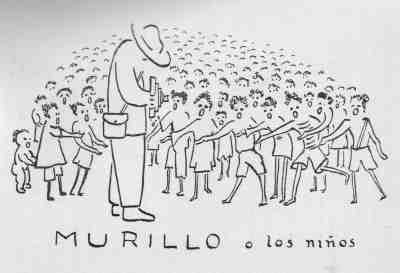Chapter Ten - Y los Otros
Y los Otros
THERE is nothing more I can marvel at; after Goya. I cannot stand in amazement before any of the masters, light or dark. Ribera is one of those dark and stern painters; I like his gaunt old men and sinewy fellows to whom he gives the names of saints and martyrs; but here is a holier master, half earthly and half redeemed, black as a cowl and white as an ironed surplice, and that is Zurbarán; his name is broad and sturdy like his painting. All his life he painted friars, they are lanky or haggard fellows, but they are always wrought of tough fibre; they show what staunch discipline, what genuine, austere manliness formed the underlying ideas of monkhood. If you would see a glorification of man in his bony, bristly aspect, in his uncouth, unshaven condition, do not search for the portraits of army leaders or kings, but look to the great monks of the worthy and pious Zurbarán

And if you want to see Murillo, it's better to go to Seville; you will discover that what makes his work so attractive is its amourous Sevillian tenderness. His Holy Virgins in a soft, warm light - why, they are the lush girls of Seville proud and winsome damsels ; and Don Esteban, good man that he was, glorified the heavens by discovering heaven in Andalusía. He also painted pretty, curly-haired boys from Triana or one of the suburbs; to-day these pictures of boys are scattered in museums all over the world, but those boys themselves are in Spain to this very day and they roam about in all paseos and plazas making a terrific, hearty din; and when they spy a foreigner looking for the children of Murillo, they rush round him uttering a war-cry, and extort pesetas and perros from him in the unabashed and traditional manner of southern children

And now, when I take stock of Spanish art as a whole ; when i recall the wax Christs and polychrome statues with all the appurtenances of the tortured and flayed body ; the tombs which make you almost smell the actual odour of decay ; the misshapen and relentless portraits - heavens above, what a peepshow ! Spanish art has almost made a special point of displaying man as he is, with terrible emphasis and almost in a declamatory manner : Behold, this is Don Quixote ! Behold this is a king ! Behold, this is a cripple ! Lo, such a man ! Perhaps this is the Catholic denial of our sinful and mortal bodily husk ; perhaps it is -
Wait a moment, I must now add something about the Moors. You cannot conceive what artists they were; their upholstery, their tints, the architectural filigree and arched doorways, what magic and brilliance, what feverish creativeness, what proficiency in the plastic arts ! But the Koran forbade them to portray man; they were not allowed to imitate man or create idols in his image. It was the Christian re-conquest of Spain which, together with the cross, brought the image of man. It is since then, perhaps because the curse of the Koran was broken, that the image of man has occupied Spanish art so intensely and sometimes even preposterously. Up to the nineteenth century, Spain, vastly picturesque though it is, has no landscape painting ; only images of man, of man on a wooden cross, of man in the height of his power, of man the cripple, of man dead and in decay....until the apocalyptic democracy of Francisco de Goya y Lucientes
